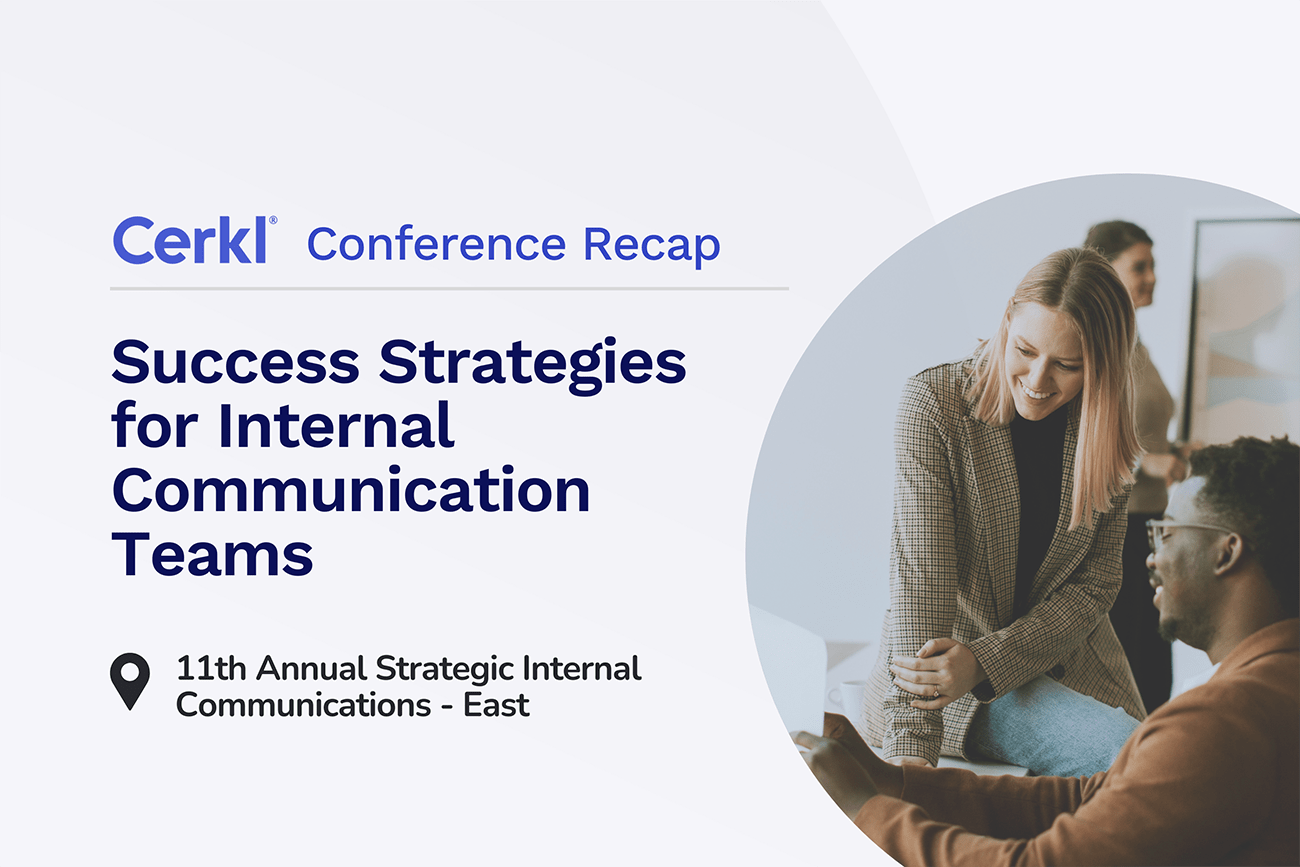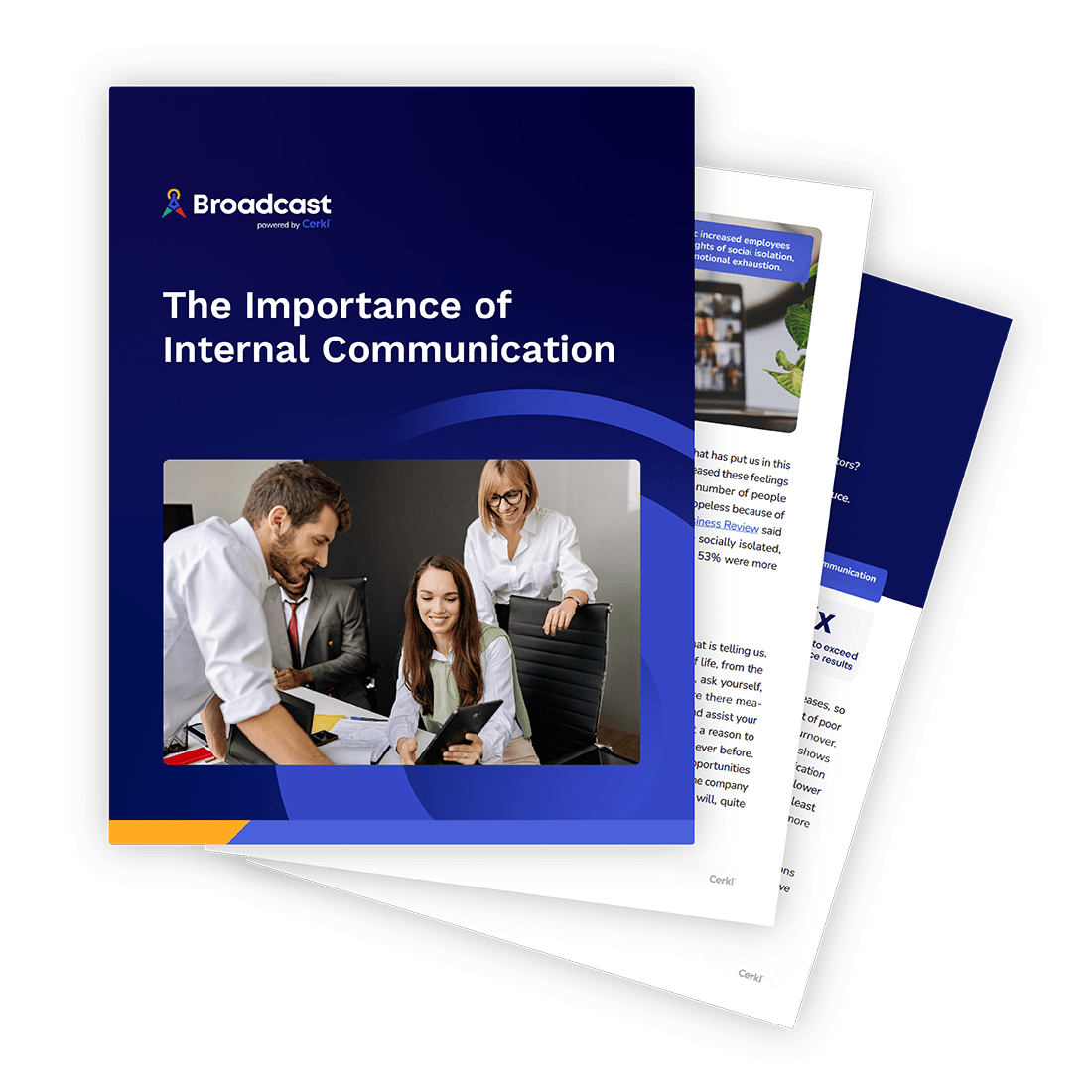Optimize internal comms with data-driven strategies. Learn how to boost ROI, engagement, and employee experience through effective metrics and tools. Don't miss out!

.webp)
Effective internal communication is the backbone of every successful organization. Learn the ins and outs of internal communications with our research-backed white paper.
Access NowCerkl Broadcast’s AI-powered platform revolutionizes internal communications by delivering highly personalized and relevant content to each employee. Leveraging advanced analytics, Cerkl analyzes employee data and behavior to curate tailored messages, fostering engagement and strengthening the employee experience. Continuously evolving to meet the dynamic needs of modern workplaces, Cerkl is committed to pushing the boundaries of internal communications technology.
To do this, Cerkl is constantly addressing challenges, creating solutions, and devising success strategies that will improve internal communications.
Topics related to internal communication success strategies were top of mind at the 11th Annual Strategic Internal Communications - East conference, Cultivating A Culture of Connection: Strategic Internal Communications Strategies To Foster The New Employee Experience In 2024. Held in Boston recently, it is one of the leading conferences for internal communications, so Cerkl opted once again to host its popular pre-conference workshop for attendees. Cerkl team members also delivered a short presentation on AI and how it enhances internal communications and all-important personalization of comms.
On Day 1 of the conference Maddy Rieman, Head of Customer Success at Cerkl, led an interactive workshop. She joined forces with Carly Toyzan, Senior Manager of Client Relations at Cerkl, for a presentation on AI during Day 2.

Maddy’s workshop highlighted the top 10 communication challenges that she has identified while working with thousands of IC customers around the globe for the past decade.
With more than 75 people participating in Maddy’s interactive workshop, this was a strong turnout. Each participant was given four colored dots allowing them to interactively participate in the discussion around the top 10 internal comms challenges. Here’s how it worked:
This allowed anyone who may have voted green for that topic to actively provide insight into how their organization has overcome that IC pain, ideally sharing best practices and tangible steps for those who may have voted red for that same topic.
With such a large crowd participating, Maddy didn’t anticipate being able to tackle all 10 challenges but instead focused on the five topics listed below:
Check out the final dot voting scale below, don’t worry, wherever you would have voted, you can see you are not alone.

A big question is how do you identify the comms metrics that matter most.
Her response is that you need to tie it back to the business value. “You will always hear more about your metrics than anyone else in the company, and you should,” said Maddy. “It's how you tell that story to them and how you compare it to other previous campaigns.”
For example, just highlighting a 58% open rate doesn’t mean anything. You need to analyze in more detail. There might be a discrepancy when it is compared to similar stats the previous year. So you need to have a baseline and then compare other best practices, different regions and so on.
It needs focus and the right tools. Maddy suggests communicators might want to look at the tools they have and then use AI to expand the analysis.
“You might want to look at your facilities or your divisions. But what about millennial women in Chicago? You might never put those three specific things together.”
She continued, asking what if the data is underlying them telling you that you have a communication issue with this subset, this group. Being able to utilize tools and understand the data behind the scenes, you may be able to look for them. See if you can segment them and track the metrics for millennial females in Chicago.
Once you have smart tools and are working with people who might understand the day-to-day workings, you can start investigating. There are a lot of techniques and metrics that are part of the data network.
Ultimately, it’s vital to know what statistics mean and why you are analyzing them.
A major challenge for many people is digital signage. “How are you supposed to do that?” asks Maddy. “That's a question I have. Baby steps, all while running. A big one to start with, right? What is your baseline? What story are you telling?”
Then there’s the question, What tools are available to you? Maddy suggested that internal communicators empower themselves by asking HR, IT or sourcing contacts about the technology available within their company. “You might not own the tool. What is a contract like? When does that contract expire? How can you pay for that subscription?”
Turn your internal communications strategy around today

When it comes to data it gets really tricky. Data is “a real thing,” but managing it can be complex. For instance, an organization like Cerkl may have data for the entire state of Ohio, but determining how to break it down into useful segments is challenging. Without proper segmentation and merging, it isn’t possible to effectively analyze the data or make informed decisions.
A simple example is that you might have employees that go back to the main center for their day-to-day work.
When we talk about effective communications, a typical issue is that people’s positions change. This has a critical impact on whether and how they respond to communications. Also, there is a definite difference in terms of how different workforce generations respond. “We hear a lot of times older generations prefer long-form text. Younger generations, they're like, just give me a GIF of what button or how to click and you just answer.”
When you create a strategy for effective communication, Maddy emphasizes that you need to integrate different versions.
“So, having your tool, having a template where you're saying, whatever piece of prompt has to be tied back to a due version. A banner version has to be graphic. It has to be creative. Also, a square profile has to be creative. What does this look like in the long form? And finding a system that should link that. What is your system of record? So, the system of record is your system that goes back to everything. What is that system of record? So, there's an internet, right? There's SharePoint, or Capio, or Igloo — there's a bunch of them out there. But, finding that system of record when you do have that digital signage that has a QR code, it can come back to that celebration.
“It also helps with metrics. Building a fluid metric line campaign based on the physical site is now taking us back to the place of renovation to use these other metrics again.”
Additionally, personalization is something that is entrenched in the Cerkl Broadcast approach to internal communications. It recognizes that employees want to get their jobs done. To do it, they want to receive comms in the format that works for them.
Turn your internal communications strategy around today

AI is hugely topical in the internal communications industry right now. It is impacting every element of internal communications and providing ways to personalize at scale. It can’t do everything, and it isn’t a threat to human employees. But what can it do? Maddy and Carly compared notes.
Carly discussed the importance of AI in internal communications and emphasized that internal communicators need to be comfortable driving the conversation about AI in their companies.
Maddy explained how AI and machine learning can help create personalized experiences for employees at scale, making it easier to reach employees through various channels like Teams, the intranet and a company mobile app.
She put it like this: “It's impossible for you as an individual to create a personalized experience for every one of your employees, right? 10,000 employees, 150,000, even 50 employees. You can't do it as one singular human.”
“We've been able to personalize it at a larger scale and reduce the tedium. This allows for increased inclusivity across the board, which we all need and require to continue to grow and be successful as businesses,” Maddy said.

That’s why Cerkl has been using machine learning for the past decade.
Carly shared her experience with targeted content in her previous roles as an internal communicator. She discussed how AI can automate and improve this process, making it less tedious and more effective. She also highlighted that it allows more time for creating engaging content that matters to company culture. But she emphasized that AI cannot replace the human touch in creating engaging content, such as human interest stories, which are popular among employees.
Up your internal communications game and boost employee engagement, information flow, and ROI with Cerkl Broadcast.
Broadcast can help you optimize your analytic metrics and improve your internal communication strategies. Want to know more?

Turn your internal communications strategy around today

Turn your internal communications strategy around today